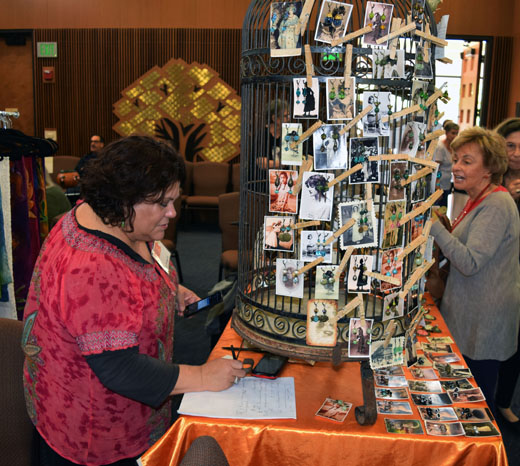
By Donald H. Harrison
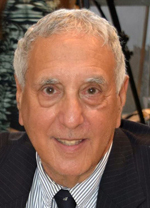
SAN DIEGO – At the annual artisans’ fair at Temple Emanu-El, one often meets people who re-purpose their materials, and in some cases, those who have re-purposed their lives.
Harvey and Carol Korfin, for example, sell glass specialty items as well as clocks mounted interestingly on old computer boards. Before turning their avocations into a small business, they retired from careers as a financial adviser and health insurance salesperson respectively.
Sarita Wosicki Segal fuses regular glass and dichroic glass, then mounts 22-carat gold decals on the product to fashion pendants of various designs. She says she never knew she had an artistic bone in her body until she started doing little school projects with her granddaughter Arabel, now 5.
Lili Feingold, whose father was a jeweler with that last name to match, for the last 19 years has been fashioning jewelry modeled on that worn by women in other eras. She utilizes old photographs of her friends’ parents and grandparents to help customers visualize the outfits the jewelry might have accompanied.
During the artisans’ fair on Sunday, Nov. 5, several artists told this interviewer a little bit about how they got started, and the processes they use to fashion items for sale.
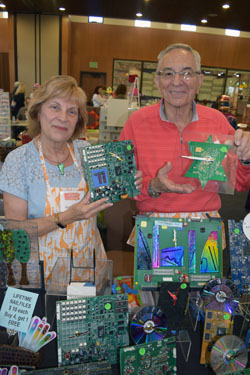
Harvey Korfin said his son Rick is a computer engineer, who left an old computer board in the Korfins’ combination garage and workroom at their Carmel Valley home. “I was going to get rid of it and someone said, “Make something out of it,” so we made a clock, and the next show we went to, it sold within 10 minutes.”
Pleased with that success, Korfin “started making clocks and now I am in my sixth season.” Some 40 years ago, before he became a financial planner, Korfin was a contractor, so building things came naturally to him.
“You take the board, look where the clock can go, drill it, and mount it,” Korfin said in describing his process. “If the board has a lot of chips and components on it, sometimes I will take an old CD and attach it to the board and then put the clock onto the CD.”
Korfin advertises on a neighborhood website to get old computers, offering a Starbucks gift card to anyone who lets him re-purpose their old computers. If people are concerned about privacy of the information stored on their computers, “I promise that if they bring it to me, in their presence I will destroy the hard drive. If they don’t want that, then I will take the hard drive and magnetize it. Inside the hard drive are some really cool CDs. I disassemble the computers then take them to a proper recycle place when I’m done. Sometimes I take them to a recycler off Miramar Road, and sometimes I take them to Goodwill, which can sell the scrap metal and make a profit.”
To date, said Korfin, he has sold over 500 repurposed computer clocks
Besides enjoying himself making art, Korfin has a sense of mission.
“I believe we have become a throw-away world,” he said. “In the old days, computers would be fixed because they were so expensive; but today with the new computers, it doesn’t pay to fix them because of the labor cost. Cell phones, too, have gotten to a point where you just buy new ones. Most electronics they don’t repair anymore. So, when I can take computers, re-purpose them, and make them into something useful, I think it’s a good idea.”
Re-purposing and recycling carries over to his home life as well, Korfin said.
“We separate all the glass and paper, I think it’s important,” he said. Recently he took outdated pharmaceuticals in his house to the local police department for recycling, and he also recycles all his batteries. Many of the tools at his work bench are battery operated.
“The environment is changing,” he commented. “Maybe my little bit helps.”
*
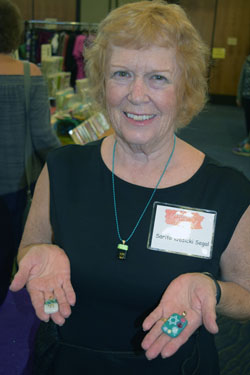
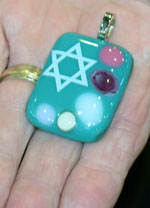
Sarita Wosicki Segal said making fused-glass pendants involves firing the materials twice in a kiln.
“I take the dark plain glass and match it with a piece of dichroic, and a clear piece of glass, all of which are hand-cut so they will fit with each other. Then I fire it. When it comes out of the kiln, I apply the decal which has to be 22-carat gold, or it won’t come out clear. The decal goes onto the pendant and then it goes back for a second firing, and after the second firing, everything is fused together.”
The designs on the pendants could be Chinese characters, or silhouettes of horses, or for audiences with a yen for Judaica, the Hebrew word for life, “Chai”; Stars of David; or menorahs.
Segal makes her creations in a studio that she rents from Fusion Glass in La Mesa. The people at the studio have taught her techniques, and by working at her station, she demonstrates the process to customers who come into the store.
Making jewelry, said Segal, “is so meditative, peaceful, and calm. I work with my jewelry and time is suspended, worry is suspended; it is like four hours of Shabbat in the middle of the week.”
*
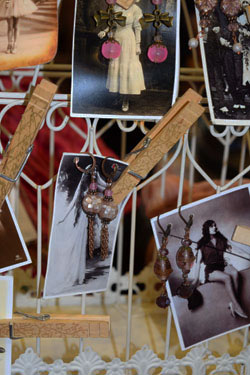
For Lili Feingold, half the job is haunting yard sales, church bazaars, and neighborhood shows. “I look for good beads, with vintage glass that might be worn, or for broken jewelry. I sanitize everything, and give it a second life.
“A lot of times it is junk jewelry that people toss, but I turn it into necklaces — and into my living,” she said.
Her creations may also utilize old pearls, buttons, coins, watch faces, and keys – anything that would help her invoke earlier eras.
She sells the jewelry attached to photos of women from the era they invoke. Then, whimsically, she fastens the photos with jewelry to a bird cage, using clothes pins. It is a novel way to display her innovative work.
She obtains the photos from friends, copies them, then manipulates the copies using Photo Shop, and has the results printed on card stock.
“Some of the granddaughters are tickled that their moms and grandmas are my models,” said Feingold. “It’s a way of honoring them.”
*
In all, there were 41 tables at which artisans and artists displayed their wares, with each table bringing $50 to the organization known as “Women of Temple Emanu-El: Sisters by Choice.” The $2,050 in revenue was supplemented by a silent auction of prizes submitted by each of the artists or artisans.
While, as fundraisers go, this is not a major event, Bonnie Baron, one of five committee members who puts the annual show together, said the event is valuable as a showcase for the artisans, many of whom are Temple Emanu-El members, and because it has a homey, neighborhood type of feeling about it, where people can visit, admire work, and not feel pressured to buy anything, but often do.
*
Harrison is editor of San Diego Jewish World. He may be contacted via donald.harrison@sdjewishworld.com